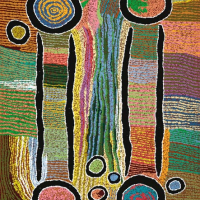MAGGIE WATSON NAPANGARDI

Maggie Watson was a leader amongst a group of Warlpiri women artists who began to challenge the dominance of mens acrylic painting in the central desert region from the mid-1980s. The emergence of these women in Yuendumu and simultaneously in Utopia (amongst Anamtjerre and Alyawarre peoples) challenged the false anthropological assumption that men were the sole guardians of the visual life of these communities. The historical evolution of the movement of which Maggie was part, began with the encouragement of more permanent painting techniques in the 1970s in both Yuendumu and Papunya, followed by the introduction of acrylic paints in the 1980s, with the women artists progressing from painting ritual objects for sale, to painting on boards as a source of revenue.
In the mid-1980s, these women traded the traditional desert ochres used for ceremony in favour of the vibrant acrylics for their painting, seizing an opportunity to express their feeling for country in a new and unforeseen way. The use of bright colour and richly textured surfaces became the hallmark of Maggie Watsons paintings in particular. Her willingness to adopt vibrant acrylic colours was founded upon the Warlpiris womens response to shiny, shimmering surfaces. During ceremony women apply red ochre mixed with animal fat to their skin. It is associated with the health, vitality, beauty and allure of their female ancestors. Maggie Watsons works are characterised by striated bands of alternating colour, shimmering across the surface of her canvases. They mimic the movement of the ancestral women as they danced across the landscape; the claypans, soakages and sandhill country through which they passed.
In the present work, the grandeur of the country is mapped out with an impressive geometry of clearly delineated roundels joined by ribbons of finely dotted colour. Flowing like rivers from one junction to another they create an intriguing patchwork, using an inventive palette of soft browns, tans, oranges, vermilions and yellows, skilfully offset with white, bringing a brilliant shimmer and depth to the surface.
During the Dreaming, digging sticks (Kana) magically emerged from the land at Mina Mina, equipping a large number of ancestral women for their travels over a vast stretch of country. The tall Desert Oaks (Kurrkapi), which grow near Mina Mina, symbolise the emergence of the womens digging sticks that literally rose up from beneath the ground during the Dreamtime. To this day they are thought of as both the living embodiments of those digging sticks as well as the lithe, upright young women who were amongst their bearers. As the women danced their way across the desert in joyous exultation they clutched the digging sticks in their outstretched hands. Dancing in a long line, they created important sites and encountered other Dreamings. Hundreds of these women travelled on the long journey first toward the east, then to the north, then south collecting plants and foods with both medicinal and ceremonial uses. They visited many sites, resting at some, going underground at others and later re-emerging or morphing into different, sometimes malevolent, beings. These powerful ancestral women were involved in initiation ceremonies and used human hair-string spun and rubbed with special red ochre and fat as part of their magic.
In 1985, Maggie Watson had her first exhibition at Araluen Arts Centre in Alice Springs. It was the beginning of a career of some 13 years, which would see her work eventually collected in major galleries in Australia and overseas. These include the major exhibitions Yuendumu: Paintings out of the Desert, the South Australian Museum exhibition in 1988 and Power of the Land Masterpieces of Aboriginal Art at the National Gallery of Victoria in 1994. Her work has been exhibited internationally in the United States of America, Africa, France, Germany, United Kingdom and New Zealand.
Staff Writer